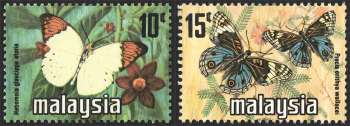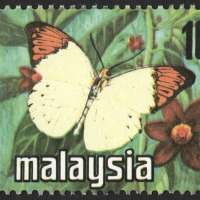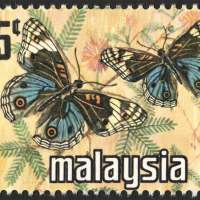STAMP PHILATELY
Malaysia - Butterflies COIL STAMPS : Pair (1976) MNH
GENERAL INFORMATION
Country
Malaysia
Type
Stamp (Complete Set)
Class
Definitive / Regular Issues
Front Inscription
Hebomoia glaucippe aturia
Precis orithya wallacei
Precis orithya wallacei
Issued Date
19/01/1976
Designer
Victor Whiteley
Printer
Harrison & Sons Limited
Printing Method
Lithography
Gum
Gum
Perforation Gauge
13½
Perforation Type
Normal Perforations
IN COLLECTION CONDITION
Preliminary
Normal
Condition
Mint Never Hinged - Superb
CATALOG INFORMATION
143
Standard Stamp Catalog of Malaysia, Singapore & Brunei
144
Standard Stamp Catalog of Malaysia, Singapore & Brunei
Malaysia - Butterflies COIL STAMPS : Pair (1976) MNH
On 31 August 1970, the first part of a new set of high value stamps was issued for use throughout Malaysia and on 1 February 1971 new sets of low value stamps were issued for use in the individual States, replacing the previous Birds and Orchids stamp issue. The new stamps featured Malaysian butterflies on all values and were printed by Bradbury Wilkinson.
The designs were by Victor Whiteley, depicting the butterflies against their natural food sources.
Harrison ‘Malaysia’ Coil Stamps, 1976
On 19 January 1976, coil stamps for the values of 10¢ and 15¢ were placed on sale at 58 locations throughout Malaysia, including Ipoh, Kuala Lumpur (approximately ten machines), Penang and several in Sarawak. Unusually, they were printed by Harrison & Sons in five-colour photogravure, and not by Bradbury Wilkinson. The stamps were produced as coils of 1000. Often, the perforations were trimmed on the left or right as the coils were mechanically cut from rolls during production.
The coil stamps had a design adapted from the State stamps of the same value, but inscribed ‘Malaysia’ and were perforated 13.8 × 13.6 on unwatermarked paper.
The British-made ‘single value’ coil machines were designed to accept 10¢ coins, one 10¢ stamp for 10¢ or two 15¢ stamps for 30¢, these being the most heavily used values for local unsealed and sealed letter rates. The machines often failed to accept the coins, deliver the number of stamps paid for, or deliver any stamps at all when coins were accepted. As a result, the majority of stamps sold appear to have been as a result of the machines being opened by a postal official, who dispensed stamps by hand, mainly to philatelists. After the initial stocks were used up, this service was, not surprisingly, discontinued. One of the main problems appeared to be humidity, causing the stamps to stick together on the roll. Recently, a variant of the gum used has come to light, showing a series of ribs along the stamp gum, which is much darker than the normal. It is possible that several gums were used experimentally during this period.
As a result of the difficulties of obtaining coil stamps, genuine commercial usage is scarce, most used examples being philatelic, and the experiment with coil stamps was never repeated. (It is interesting to note that similar trials took place on later issues with booklet dispensing machines, with very similar results.)
Proof stamps are known to exist.
REFERENCE
The Butterfly Definitives of Malaysia, 1971 to 1978—Part 1, Mac McClaren, Gibbons Stamps Monthly April 2009
The designs were by Victor Whiteley, depicting the butterflies against their natural food sources.
Harrison ‘Malaysia’ Coil Stamps, 1976
On 19 January 1976, coil stamps for the values of 10¢ and 15¢ were placed on sale at 58 locations throughout Malaysia, including Ipoh, Kuala Lumpur (approximately ten machines), Penang and several in Sarawak. Unusually, they were printed by Harrison & Sons in five-colour photogravure, and not by Bradbury Wilkinson. The stamps were produced as coils of 1000. Often, the perforations were trimmed on the left or right as the coils were mechanically cut from rolls during production.
The coil stamps had a design adapted from the State stamps of the same value, but inscribed ‘Malaysia’ and were perforated 13.8 × 13.6 on unwatermarked paper.
The British-made ‘single value’ coil machines were designed to accept 10¢ coins, one 10¢ stamp for 10¢ or two 15¢ stamps for 30¢, these being the most heavily used values for local unsealed and sealed letter rates. The machines often failed to accept the coins, deliver the number of stamps paid for, or deliver any stamps at all when coins were accepted. As a result, the majority of stamps sold appear to have been as a result of the machines being opened by a postal official, who dispensed stamps by hand, mainly to philatelists. After the initial stocks were used up, this service was, not surprisingly, discontinued. One of the main problems appeared to be humidity, causing the stamps to stick together on the roll. Recently, a variant of the gum used has come to light, showing a series of ribs along the stamp gum, which is much darker than the normal. It is possible that several gums were used experimentally during this period.
As a result of the difficulties of obtaining coil stamps, genuine commercial usage is scarce, most used examples being philatelic, and the experiment with coil stamps was never repeated. (It is interesting to note that similar trials took place on later issues with booklet dispensing machines, with very similar results.)
Proof stamps are known to exist.
REFERENCE
The Butterfly Definitives of Malaysia, 1971 to 1978—Part 1, Mac McClaren, Gibbons Stamps Monthly April 2009
COMMENTS
NEW COMMENT
|
The following text must accompany any text or photo taken from this page and limited use for non-commercial purposes only.
Texts and Images were taken from and courtesy of Exonumi.com
URL: http://www.exonumi.com/publish-SP.1.2040
|
|


